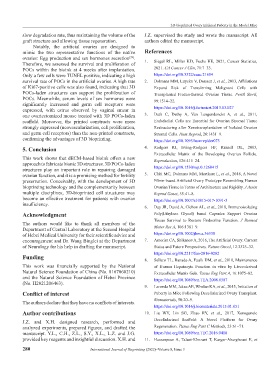Page 288 - IJB-8-3
P. 288
3D-bioprinted Ovary Initiated Puberty in the Model Mice
slow degradation rate, thus maintaining the volume of the J.Z. supervised the study and wrote the manuscript. All
graft structure and allowing tissue regeneration. authors edited the manuscript.
Notably, the artificial ovaries are designed to
mimic the two representative functions of the native References
ovaries: Egg production and sex hormones secretion . 1. Siegel RL, Miller KD, Fuchs HE, 2021, Cancer Statistics,
[39]
Therefore, we assessed the survival and proliferation of
POCs within the bioink at 4 weeks after implantation. 2021. CA Cancer J Clin, 71:7–33.
Only a few cells were TUNEL positive, indicating a high https://doi.org/10.3322/caac.21654
survival rate of POCs in the artificial ovaries. A high rate 2. Dolmans MM, Luyckx V, Donnez J, et al., 2013, Affiliations
of Ki67-positive cells was also found, indicating that 3D Expand Risk of Transferring Malignant Cells with
POCs-laden structures can support the proliferation of Transplanted Frozen-thawed Ovarian Tissue. Fertil Steril,
POCs. Meanwhile, serum levels of sex hormones were 99:1514–22.
significantly increased and germ cell receptors were
expressed, with estrus observed by vaginal smear in https://doi.org/10.1016/j.fertnstert.2013.03.027
one ovariectomized mouse treated with 3D POCs-laden 3. Dath C, Dethy A, Van Langendonckt A, et al., 2011,
scaffold. Moreover, the printed constructs were more Endothelial Cells are Essential for Ovarian Stromal Tissue
strongly expressed (neovascularization, cell proliferation, Restructuring after Xenotransplantation of Isolated Ovarian
and germ cell receptors) than the non-printed constructs, Stromal Cells. Hum Reprod, 26:1431–9.
confirming the advantages of 3D bioprinting. https://doi.org/10.1093/humrep/der073
5. Conclusion 4. Rodgers RJ, Irving-Rodgers HF, Russell DL, 2003,
Extracellular Matrix of the Developing Ovarian Follicle.
This work shows that dECM-based bioink offers a new Reproduction, 126:415–24.
approach to fabricate bionic 3D structures. 3D POCs-laden https://doi.org/10.1530/rep.0.1260415
structures play an important role in repairing damaged
ovarian function, and it is a promising method for fertility 5. Chiti MC, Dolmans MM, Mortiaux L, et al., 2018, A Novel
preservation. Conceivably, with the development of 3D Fibrin-based Artificial Ovary Prototype Resembling Human
bioprinting technology and the complementarity between Ovarian Tissue in Terms of Architecture and Rigidity. J Assist
multiple disciplines, 3D-bioprinted cell structures may Reprod Genet, 35:41–8.
become an effective treatment for patients with ovarian https://doi.org/10.1007/s10815-017-1091-3
insufficiency.
6. Day JR, David A, Cichon AL, et al., 2018, Immunoisolating
Acknowledgment Poly(Ethylene Glycol) based Capsules Support Ovarian
Tissue Survival to Restore Endocrine Function. J Biomed
The authors would like to thank all members of the Mater Res A, 106:1381–9.
Department of Central Laboratory at the Second Hospital
of Hebei Medical University for their scientific advice and https://doi.org/10.1002/jbm.a.36338
encouragement and Dr. Wang Binglei at the Department 7. Amorim CA, Shikanov A, 2016, The Artificial Ovary: Current
of Neurology for his help in drafting the manuscript. Status and Future Perspectives. Future Oncol, 12:2323–32.
https://doi.org/10.2217/fon-2016-0202
Funding 8. Sellaro TL, Ranade A, Faulk DM, et al., 2010, Maintenance
This work was financially supported by the National of Human Hepatocyte Function in vitro by Liver-derived
Natural Science Foundation of China (No. 8167060210) Extracellular Matrix Gels. Tissue Eng Part A, 16:1075–82.
and the Natural Science Foundation of Hebei Province https://doi.org/10.1089/ten.TEA.2008.0587
(No. H2021206463).
9. Laronda MM, Jakus AE, Whelan KA, et al., 2015, Initiation of
Conflict of interest Puberty in Mice Following Decellularized Ovary Transplant.
Biomaterials, 50:20–9.
The authors declare that they have no conflicts of interests.
https://doi.org/10.1016/j.biomaterials.2015.01.051
Author contributions 10. Liu WY, Lin SG, Zhuo RY, et al., 2017, Xenogeneic
J.Z. and X.H. designed research, performed and Decellularized Scaffold: A Novel Platform for Ovary
analyzed experiments, prepared figures, and drafted the Regeneration. Tissue Eng Part C Methods, 23:61–71.
manuscript. Y.L., C.H., Z.L., S.Y., X.L., L.Z. and J.G. https://doi.org/10.1089/ten.TEC.2016.0410
provided key reagents and insightful discussion. X.H. and 11. Hassanpour A, Talaei-Khozani T, Kargar-Abarghouei E, et
280 International Journal of Bioprinting (2022)–Volume 8, Issue 3

